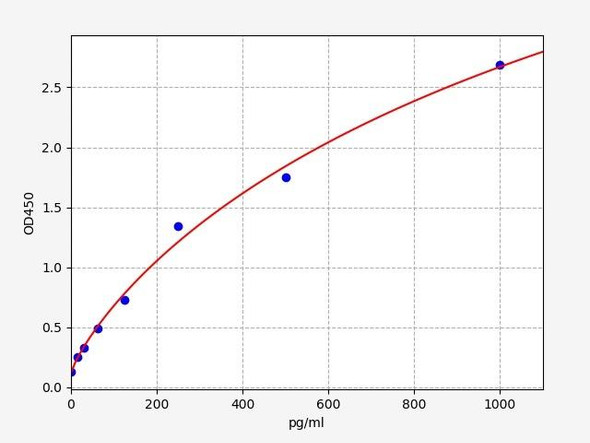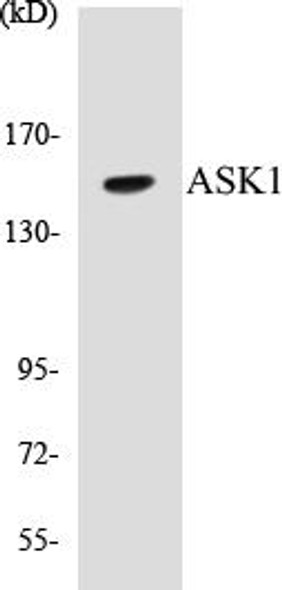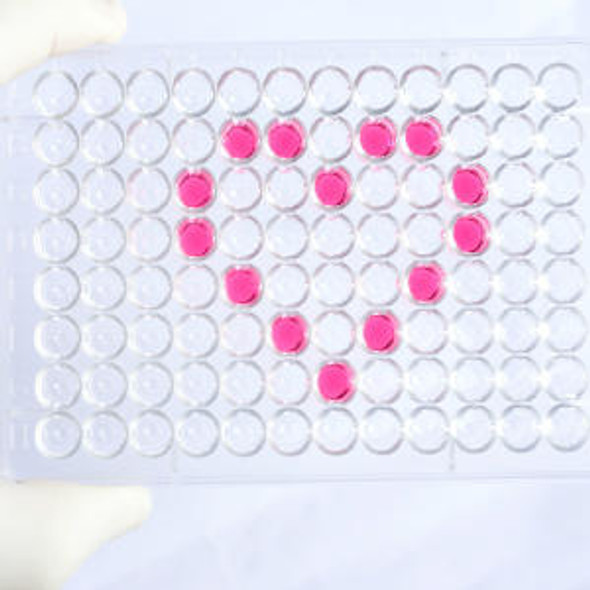Human MAP3K5 / ASK1 ELISA Kit
- SKU:
- HUFI02233
- Product Type:
- ELISA Kit
- Size:
- 96 Assays
- Uniprot:
- Q99683
- Sensitivity:
- 0.188ng/ml
- Range:
- 0.313-20ng/ml
- ELISA Type:
- Sandwich
- Synonyms:
- ASK-1, MAP3K5, MEKK5, Apoptosis signal-regulating kinase 1, ASK-1, ASK1MEKK 5, EC 2.7.11, MAP, ERK kinase kinase 5, MAPK, ERK kinase kinase 5, MAPKKK5EC 2.7.11.25, MEK kinase 5, MEKK5apoptosis signal regulating kinase 1, mitogen-activated protein kin
- Reactivity:
- Human
- Research Area:
- Cell Death
Description
Human MAP3K5 / ASK1 ELISA
Mitogen-activated protein kinase (MAPK) signalling pathways include extracellular signal-regulated kinase (ERK), MAPK kinase (MKK or MEK), and MAPK kinase kinase (MAPKKK or MEKK). MAPKK kinase/MEKK phosphorylates and activates downstream MAPK kinase/MEK, which then activate MAPK. The protein, MAPKKK5, has 1,374 amino acids and all 11 kinase subdomains. MAPKKK5 is abundantly expressed in the human heart and pancreas. In vitro, the MAPKKK5 protein phosphorylates and activates MKK4, while in transient expression in COS and 293 cells, it activates c-Jun N-terminal kinase (JNK)/stress-activated protein kinase (SAPK). MAPKKK5 does not activate MAPK/ERK. Glottis squamous cell carcinoma and non-Alcoholic fatty liver disease are two diseases linked to MAP3K5. GDNF-family ligands and receptor interactions, as well as RANK signalling in osteoclasts, are all connected to MAPKKK5 pathways. Protein heterodimerization activity and protein kinase activity are two GO annotations linked to MAPKKK5. MAP3K15 is a paralog of MAPKKK5 .
| Product Name: | Human MAP3K5 / ASK1 ELISA Kit |
| Product Code: | HUFI02233 |
| Size: | 96 Assays |
| Alias: | ASK-1, MAP3K5, MEKK5, Apoptosis signal-regulating kinase 1, ASK-1, ASK1MEKK 5, EC 2.7.11, MAP, ERK kinase kinase 5, MAPK, ERK kinase kinase 5, MAPKKK5EC 2.7.11.25, MEK kinase 5, MEKK5apoptosis signal regulating kinase 1, mitogen-activated protein kinase kinase kinase 5 |
| Detection method: | Sandwich ELISA, Double Antibody |
| Application: | This immunoassay kit allows for the in vitro quantitative determination of Human ASK-1 concentrations in serum plasma and other biological fluids. |
| Sensitivity: | 0.188ng/ml |
| Range: | 0.313-20ng/ml |
| Storage: | 4°C for 6 months |
| Note: | For Research Use Only |
| Recovery: | Matrices listed below were spiked with certain level of Human ASK-1 and the recovery rates were calculated by comparing the measured value to the expected amount of Human ASK-1 in samples. | ||||||||||||||||
| |||||||||||||||||
| Linearity: | The linearity of the kit was assayed by testing samples spiked with appropriate concentration of Human ASK-1 and their serial dilutions. The results were demonstrated by the percentage of calculated concentration to the expected. | ||||||||||||||||
| |||||||||||||||||
| CV(%): | Intra-Assay: CV<8% Inter-Assay: CV<10% |
| Component | Quantity | Storage |
| ELISA Microplate (Dismountable) | 8×12 strips | 4°C for 6 months |
| Lyophilized Standard | 2 | 4°C/-20°C |
| Sample/Standard Dilution Buffer | 20ml | 4°C |
| Biotin-labeled Antibody(Concentrated) | 120ul | 4°C (Protect from light) |
| Antibody Dilution Buffer | 10ml | 4°C |
| HRP-Streptavidin Conjugate(SABC) | 120ul | 4°C (Protect from light) |
| SABC Dilution Buffer | 10ml | 4°C |
| TMB Substrate | 10ml | 4°C (Protect from light) |
| Stop Solution | 10ml | 4°C |
| Wash Buffer(25X) | 30ml | 4°C |
| Plate Sealer | 5 | - |
Other materials and equipment required:
- Microplate reader with 450 nm wavelength filter
- Multichannel Pipette, Pipette, microcentrifuge tubes and disposable pipette tips
- Incubator
- Deionized or distilled water
- Absorbent paper
- Buffer resevoir
| Uniprot | Q99683 |
| UniProt Protein Function: | ASK1: a MAP kinase kinase kinase of the STE11 family, apoptosis signal-regulating kinase 1 (ASK1) plays essential roles in stress-induced apoptosis. Activated by various stressors, including oxidative stress, endoplasmic reticulum stress, and calcium overload, as well as by receptor-mediated inflammatory signals, such as the tumor necrosis factor (TNF) and lipopolysaccharide (LPS). In turn, ASK1 phosphorylates and activates two different subgroups of MAP kinase kinases, MKK4/SEK1 and MKK3/MKK6, which in turn activate stress-activated protein kinases (JNKs) and p38 subgroups of MAP kinases, respectively. Overexpression activates JNK and p38 and induces apoptosis in several cell types through signals involving the mitochondrial cell death pathway. Embryonic fibroblasts or primary neurons derived from ASK1-/- mice are resistant to stress-induced JNK and p38 activation as well as cell death. Oxidative stress induces the activation of ASK1, which correlate with ASK1 activity and ASK1-dependent apoptosis. Required for the innate immune response, which is essential for host defense against a wide range of pathogens. |
| UniProt Protein Details: | Protein type:EC 2.7.11.25; Kinase, protein; Protein kinase, STE; Protein kinase, Ser/Thr (non-receptor); STE group; STE11 family Chromosomal Location of Human Ortholog: 6q23.3 Cellular Component: cytosol Molecular Function:ATP binding; magnesium ion binding; MAP kinase kinase kinase activity; protein binding; protein homodimerization activity; protein kinase activity; protein phosphatase binding; protein serine/threonine kinase activity Biological Process: activation of JNK activity; activation of MAPKK activity; induction of apoptosis by oxidative stress; JNK cascade; MAPKKK cascade; positive regulation of apoptosis; positive regulation of caspase activity; positive regulation of JNK activity; positive regulation of JNK cascade; protein amino acid phosphorylation |
| NCBI Summary: | Mitogen-activated protein kinase (MAPK) signaling cascades include MAPK or extracellular signal-regulated kinase (ERK), MAPK kinase (MKK or MEK), and MAPK kinase kinase (MAPKKK or MEKK). MAPKK kinase/MEKK phosphorylates and activates its downstream protein kinase, MAPK kinase/MEK, which in turn activates MAPK. The kinases of these signaling cascades are highly conserved, and homologs exist in yeast, Drosophila, and mammalian cells. MAPKKK5 contains 1,374 amino acids with all 11 kinase subdomains. Northern blot analysis shows that MAPKKK5 transcript is abundantly expressed in human heart and pancreas. The MAPKKK5 protein phosphorylates and activates MKK4 (aliases SERK1, MAPKK4) in vitro, and activates c-Jun N-terminal kinase (JNK)/stress-activated protein kinase (SAPK) during transient expression in COS and 293 cells; MAPKKK5 does not activate MAPK/ERK. [provided by RefSeq, Jul 2008] |
| UniProt Code: | Q99683 |
| NCBI GenInfo Identifier: | 6685617 |
| NCBI Gene ID: | 4217 |
| NCBI Accession: | Q99683.1 |
| UniProt Secondary Accession: | Q99683,Q5THN3, Q99461, A6NIA0, B4DGB2, |
| UniProt Related Accession: | Q99683 |
| Molecular Weight: | 69,839 Da |
| NCBI Full Name: | Mitogen-activated protein kinase kinase kinase 5 |
| NCBI Synonym Full Names: | mitogen-activated protein kinase kinase kinase 5 |
| NCBI Official Symbol: | MAP3K5 |
| NCBI Official Synonym Symbols: | ASK1; MEKK5; MAPKKK5 |
| NCBI Protein Information: | mitogen-activated protein kinase kinase kinase 5 |
| UniProt Protein Name: | Mitogen-activated protein kinase kinase kinase 5 |
| UniProt Synonym Protein Names: | Apoptosis signal-regulating kinase 1; ASK-1; MAPK/ERK kinase kinase 5; MEK kinase 5; MEKK 5 |
| Protein Family: | DASH complex |
| UniProt Gene Name: | MAP3K5 |
*Note: Protocols are specific to each batch/lot. For the correct instructions please follow the protocol included in your kit.
Before adding to wells, equilibrate the SABC working solution and TMB substrate for at least 30 min at 37°C. When diluting samples and reagents, they must be mixed completely and evenly. It is recommended to plot a standard curve for each test.
| Step | Protocol |
| 1. | Set standard, test sample and control (zero) wells on the pre-coated plate respectively, and then, record their positions. It is recommended to measure each standard and sample in duplicate. Wash plate 2 times before adding standard, sample and control (zero) wells! |
| 2. | Aliquot 0.1ml standard solutions into the standard wells. |
| 3. | Add 0.1 ml of Sample / Standard dilution buffer into the control (zero) well. |
| 4. | Add 0.1 ml of properly diluted sample ( Human serum, plasma, tissue homogenates and other biological fluids.) into test sample wells. |
| 5. | Seal the plate with a cover and incubate at 37 °C for 90 min. |
| 6. | Remove the cover and discard the plate content, clap the plate on the absorbent filter papers or other absorbent material. Do NOT let the wells completely dry at any time. Wash plate X2. |
| 7. | Add 0.1 ml of Biotin- detection antibody working solution into the above wells (standard, test sample & zero wells). Add the solution at the bottom of each well without touching the side wall. |
| 8. | Seal the plate with a cover and incubate at 37°C for 60 min. |
| 9. | Remove the cover, and wash plate 3 times with Wash buffer. Let wash buffer rest in wells for 1 min between each wash. |
| 10. | Add 0.1 ml of SABC working solution into each well, cover the plate and incubate at 37°C for 30 min. |
| 11. | Remove the cover and wash plate 5 times with Wash buffer, and each time let the wash buffer stay in the wells for 1-2 min. |
| 12. | Add 90 µl of TMB substrate into each well, cover the plate and incubate at 37°C in dark within 10-20 min. (Note: This incubation time is for reference use only, the optimal time should be determined by end user.) And the shades of blue can be seen in the first 3-4 wells (with most concentrated standard solutions), the other wells show no obvious color. |
| 13. | Add 50 µl of Stop solution into each well and mix thoroughly. The color changes into yellow immediately. |
| 14. | Read the O.D. absorbance at 450 nm in a microplate reader immediately after adding the stop solution. |
When carrying out an ELISA assay it is important to prepare your samples in order to achieve the best possible results. Below we have a list of procedures for the preparation of samples for different sample types.
| Sample Type | Protocol |
| Serum | If using serum separator tubes, allow samples to clot for 30 minutes at room temperature. Centrifuge for 10 minutes at 1,000x g. Collect the serum fraction and assay promptly or aliquot and store the samples at -80°C. Avoid multiple freeze-thaw cycles. If serum separator tubes are not being used, allow samples to clot overnight at 2-8°C. Centrifuge for 10 minutes at 1,000x g. Remove serum and assay promptly or aliquot and store the samples at -80°C. Avoid multiple freeze-thaw cycles. |
| Plasma | Collect plasma using EDTA or heparin as an anticoagulant. Centrifuge samples at 4°C for 15 mins at 1000 × g within 30 mins of collection. Collect the plasma fraction and assay promptly or aliquot and store the samples at -80°C. Avoid multiple freeze-thaw cycles. Note: Over haemolysed samples are not suitable for use with this kit. |
| Urine & Cerebrospinal Fluid | Collect the urine (mid-stream) in a sterile container, centrifuge for 20 mins at 2000-3000 rpm. Remove supernatant and assay immediately. If any precipitation is detected, repeat the centrifugation step. A similar protocol can be used for cerebrospinal fluid. |
| Cell culture supernatant | Collect the cell culture media by pipette, followed by centrifugation at 4°C for 20 mins at 1500 rpm. Collect the clear supernatant and assay immediately. |
| Cell lysates | Solubilize cells in lysis buffer and allow to sit on ice for 30 minutes. Centrifuge tubes at 14,000 x g for 5 minutes to remove insoluble material. Aliquot the supernatant into a new tube and discard the remaining whole cell extract. Quantify total protein concentration using a total protein assay. Assay immediately or aliquot and store at ≤ -20 °C. |
| Tissue homogenates | The preparation of tissue homogenates will vary depending upon tissue type. Rinse tissue with 1X PBS to remove excess blood & homogenize in 20ml of 1X PBS (including protease inhibitors) and store overnight at ≤ -20°C. Two freeze-thaw cycles are required to break the cell membranes. To further disrupt the cell membranes you can sonicate the samples. Centrifuge homogenates for 5 mins at 5000xg. Remove the supernatant and assay immediately or aliquot and store at -20°C or -80°C. |
| Tissue lysates | Rinse tissue with PBS, cut into 1-2 mm pieces, and homogenize with a tissue homogenizer in PBS. Add an equal volume of RIPA buffer containing protease inhibitors and lyse tissues at room temperature for 30 minutes with gentle agitation. Centrifuge to remove debris. Quantify total protein concentration using a total protein assay. Assay immediately or aliquot and store at ≤ -20 °C. |
| Breast Milk | Collect milk samples and centrifuge at 10,000 x g for 60 min at 4°C. Aliquot the supernatant and assay. For long term use, store samples at -80°C. Minimize freeze/thaw cycles. |
Fill out our quote form below and a dedicated member of staff will get back to you within one working day!






